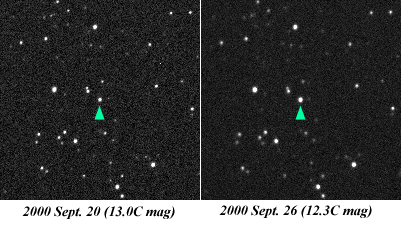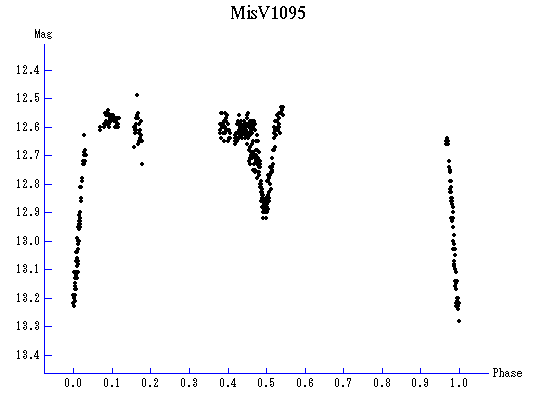Home Page Updated on December 16, 2020
MisV1095
|
| R.A. | 00h26m49s.46 | |
| Decl. | +41o49'08".9 | (2000.0) |
| Mag. | 12.64-13.24C | |
| Type | EA | |
| Period | 1.5825780 | |
| Epoch | 2452900.10190 |

= GSC 2791-02148 00h26m49s.45 +41o49'08".6 Error:0.2" Mag:12.74 Ma gError:0.40 Band:1 Class:0 Plate:01JV Flag:F Epoch:12 OCT 1983 = USNO-A2.0 1275.00278138 00h26m49s.374 +41o49'08".79 Mag(R):13.7 M ag(B):14.0 = 2MASS 002649.502 +414908.81 (2000.0) 10.746 10.161 9.987
Digitized Sky Survey GIF image (15 x 15 arcmin)
NSVS Light Curve (NSVS 3662505)
 Discovery Information
Discovery Information
Seiichi Yoshida, MISAO Project; Nobuo Ohkura, Okayama, Japan; and Ken-ichi Kadota, MISAO Project, discovered a new variable star MisV1095.
It was picked up by Seiichi Yoshida from the candidates of new variable stars detected by the PIXY system 2 from images taken by Nobuo Ohkura, and confirmed by Ken-ichi Kadota.
The identification is researched by Taichi Kato (Kyoto University), John Greaves (the United Kingdom), and Seiichi Yoshida.
 Special Notes
Special Notes
Kazuhiro Nakajima's observations revealed it is an Algol-type (EA) eclipsing variable with unfiltered CCD variations of 12.64 mag at maximum, 13.24 mag at primary minimum, 12.90 mag at secondary minimum, and period of 1.5829 days (IBVS 5600).
Times of minima observed by Ondrej Pejcha are published in the IBVS paper (IBVS 5645).
Osamu Ohshima caught the eclipse in 2008 January, and the ephemeris of elicpses are updated precisely with Kazuhiro Nakajima's observations in 2003 and further observations in Europe.
John Greaves pointed out that the USNO-B1.0 color is so red as B1-R1=2.9 mag, which suggests the spectral class is K or M type. However, Seiichi Yoshida pointed out that the USNO-A2.0 color is so blue as B-R=0.3 mag. And the 2MASS color is J-Ks=0.759 mag, intermediate between blue and red.
Therefore, it was suspected to change its color in the eclipse. However, no remarkable color change between normal phase and eclipse phase was observed by Osamu Ohshima's observations. The USNO-B1.0 color seems to erroneous.
Light curve by Hidehiko Akazawa's observations is published.
 Research and Publication
Research and Publication
-
MisV1095 is an Algol-type eclipsing variable
Nakajima, K.; Yoshida, S.; Ohkura, N.
-
David Motl (B.R.N.O.)'s chart
-
Reports on New Discoveries
IBVS 5600
Nakajima, K.; Yoshida, S.; Ohkura, N.; Kadota, K.
-
CCD Times of Minima of Several Eclipsing Binaries
IBVS 5645
Pejcha, Ondrej
-
Kazuhiro Nakajima's observations
-
Visual and CCD minima of eclipsing binaries during 2003
Variable Star Bulletin No.42
Kazuo Nagai
-
Hidehiko Akazawa's light curve
 Light Curve
Light Curve

MisV1095 is an Algol-type eclipsing variable
Nakajima, K.; Yoshida, S.; Ohkura, N.
 Observations by MISAO Project
Observations by MISAO Project
| Date | Mag | Filter | Observer |
|---|---|---|---|
| 2000 Sept. 20.61661 | 13.0 | C | Nobuo Ohkura |
| 2000 Sept. 20.61846 | 12.9 | C | Nobuo Ohkura |
| 2000 Sept. 24.61894 | 12.4 | C | Nobuo Ohkura |
| 2000 Sept. 24.62079 | 12.3 | C | Nobuo Ohkura |
| 2000 Sept. 26.60003 | 12.3 | C | Nobuo Ohkura |
| 2000 Sept. 26.60188 | 12.3 | C | Nobuo Ohkura |
| 2000 Sept. 27.63302 | 12.2 | C | Nobuo Ohkura |
| 2000 Sept. 27.63487 | 12.3 | C | Nobuo Ohkura |
| 2000 Oct. 1.61637 | 12.3 | C | Nobuo Ohkura |
| 2000 Oct. 4.60321 | 12.3 | C | Nobuo Ohkura |
| 2000 Oct. 10.59066 | 12.3 | C | Nobuo Ohkura |
| 2000 Oct. 10.59251 | 12.3 | C | Nobuo Ohkura |
| 2000 Oct. 10.59438 | 12.4 | C | Nobuo Ohkura |
| 2000 Nov. 6.50595 | 12.3 | C | Nobuo Ohkura |
| 2000 Nov. 6.50780 | 12.3 | C | Nobuo Ohkura |
| 2000 Nov. 6.50966 | 12.4 | C | Nobuo Ohkura |
| 2000 Nov. 24.46503 | 12.5 | C | Nobuo Ohkura |
| 2000 Nov. 24.46690 | 12.6 | C | Nobuo Ohkura |
| 2000 Dec. 7.38588 | 12.3 | C | Nobuo Ohkura |
| 2000 Dec. 12.41087 | 12.3 | C | Nobuo Ohkura |
